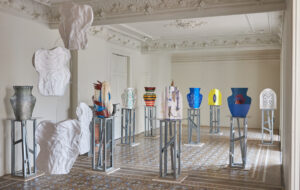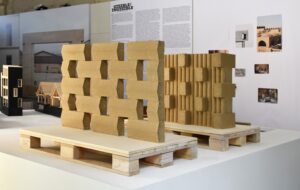|
The London-based product-design studio, Industrial Facility, who make prototypes of their minimalist designs out of paper, has also set up an online store to sell their creations that is intended as a “research tool” “Hacking?” Sam Hecht, co-founder of design studio Industrial Facility retreats into the back of his chair. “If someone hacked a product we designed, I would see that as an admission of a mistake – of a decision we made to be in the wrong direction.” It might seem an old fashioned outlook at a time when design-scene chatter is focused on user-customisation and participation. But for Hecht, a well-designed object is the sum of a list of factors: usefulness, desirability, the pursuit to improve an archetype, responsible use of materials, the comfort of the person making the product – and the client’s need to pay its staff. Hecht and the firm’s other founder Kim Colin see the handling of this equation as their craft. So if something doesn’t add up, or the end-user feels the need to make an amendment, “We would learn from that,” Hecht says. He means it. In 2009 the studio set up Retail Facility, an online shop selling a range of its products, as a research tool “to get closer to the consumers using our stuff”. Hecht says, “A woman emailed me to say she’d lost the battery cover to her Bell Clock, and it wouldn’t stand up. We thought it was clever to give the cover a double function as a stand.” He shakes his head. “We never thought that if someone lost that piece, the product would become useless. It made us realise how these tiny decisions you make impact on the final result. We could trace the moment we made the mistake.”
Locale Office system for Herman Miller, 2013 (image: Industrial Facility) It is this level of research that distinguishes Industrial Facility. The studio set up to combine the skills of Colin, a Californian SCI-Arc architecture graduate, with Hecht, a London-born design graduate of the Royal College of Art. They met at an exhibition in London, when Hecht was based in Japan at IDEO, and instantly hit it off. “At the time, industrial design was a weak subject – it was lacking,” Hecht says. Architecture, on the other hand “seemed comfortable with responsibility … With a building, there is a responsibility to the people using it, the street, the landscape, and the city, whereas with industrial design, there is no responsibility to anything, Hecht says. “I wanted to bring Colin’s dialogue to design.” In 2002, Hecht moved back to London and the pair set up the studio, joined by Ippei Matsumoto whom Hecht met in Japan.
Projector for Epson, 2006 (image: Richard Davies)
Second Phone for Muji, 2002 to 2006 (image: Muji) Hecht and Colin laid bare their agenda with two books; Product as Landscape and Things that go Unseen, manifestos of sorts. As Hecht says, it was “a device to talk to industry on our terms”. To date, this philosophy has produced a tent for Louis Vuitton, a hard drive for LaCie; a piano for Yamaha; a cycle shirt for Margaret Howell; office furniture for Herman Miller and copious everyday household objects for Muji, a brand to which Industrial Facility is contracted. Versions of these products sit neatly in a row of cabinets, at the back of Industrial Facility’s Clerkenwell studio, where we are now. Outside, the drill of road works is relentless, but Hecht is oblivious. He sits upright in his chair, with zen-like calm, and speaks with a soft, steady drone that draws you in entirely – the odd, archaic word lending him a touch of eccentricity. “Oftentimes, the things we design are the things we like,” he says, as I peer into the cabinets. “We readily admit that our work is autobiographical.”
Formwork desk accessories for Herman Miller, 2013 (image: Industrial Facility) The studio’s most recent project, a collection of 30 desktop products for Herman Miller, certainly falls into this category: “We’ve been struggling to buy these things for years,” Hecht says. “If you look at what people put in a pen cup, you’ll find staples, USB sticks and other hard-to-get things.” So the studio incorporated a cantilever around the edge to save us digging around. Industrial Facility’s study of the way we use things is an approach it describes as anthropological; it is compounded in the studio’s biggest project to date, an office furniture system, also for Herman Miller. “It was crystal-clear to us that the more you could get people to talk and collaborate, the better performance would be.” The studio’s research led to a system comprising a vertical spine, along which shelving, meeting tables and cantilevered desks attach.The desks can be easily raised and lowered, and they also have large curved corners making it easy for a group of people to sit or stand around. In short, the system enables individual workers to adjust their space to meet their needs, as opposed to “feeling like they are fitting into the employer’s, or designer’s system,” Hecht explains. Hecht says it’s this level of thinking about things and system that links the studio’s projects. But while its products might be unassuming and quiet, a subtle aesthetic language is evident: there is a fondness for simple shapes – boxes and spheres – in block colours of black, red and white. It’s a clear nod to German design veteran Dieter Rams’ work. But it’s also a consequence of the studio’s primitive prototyping tools: “We still make paper models,” Hecht says. “I’m conscious that this is very old school, but it allows us to enter into a project with a sense of reality very early on. If the end result is three-dimensional, why not start that way?” The Coffee Maker for Muji is perhaps the most direct example of this. The studio presented the client with a simple cardboard tube, describing how its cyclical shape would enable the product to sit in the middle of a counter, or snug in a corner, and blend in with the objects around it. The brand got it instantly, and the design was accepted on the spot. What makes Industrial Facility’s work particularly seductive, though, is its approach to narrative. The studio’s DVD/LCD prototype for Epson, takes its form from the Super 8 projector, placing the DVD upright and visible like a spool of film, and making the object look like it is meant to play movies. And its Ten Key Calculator, designed to connect to a laptop and “relieve some of the stress associated with typing digits using a standard qwerty keyboard” has big, spongy buttons that take you right back to your first go on a computer. In this way, the studio doesn’t just sit its objects amid a landscape of other objects; it uses cultural references to place its designs somewhere amid our memories, making us form an emotional connection with them – and in so doing, resist the urge to discard and replace.
Radice Stool for Mattiazzi, 2013 (image: Gerhardt Kellerman) Trying to explain to a brand why it should invest in a design process that navigates so many factors isn’t always easy though, especially when the brand is selling a service, and giving the product away for free – a scenario the studio faces more and more. “Companies need to decide on what level they involve desire,” Hecht says. “Most of them just want a great product as cheap as possible – that’s the reality. And most designers aren’t compelled to open up the conversation.” This disconnect from “things” as the Western economy moves increasingly away from manufacturing to service industries poses other problems too: “We’ve found that companies have lost their knowledge, because they are making things at arm’s length,” Hecht says. While some companies have maintained a healthy dialogue with their overseas manufacturing base, most have not – “and the problem is, if you lose the knowledge of how to make, you give away not just your dream, but your ability to create new dreams. You can’t dream in a space of reality, because you don’t have intelligence to build on. Mattiazzi is the perfect example of how it should work,” Hecht says. The Italian furniture company keeps all the facets of wood production under one roof and “can shape wood as if it were plastic”. “It lets the designers express this,” Hecht says. The studio’s Radice Stool for the brand, launched earlier this year, uses the manufacturer’s “robot-craftsmanship” to support the front half of a traditional four-legged stool with a single remarkably sturdy back leg.
Semplice Lamp for Oluce, 2013 (image: Industrial Facility) But as the traditional production model Mattiazzi uses is increasingly rare, is this really a realistic aspiration? “Online has helped hugely,” Hecht says. “More and more, we’re seeing individuals who have decided to pick up on some knowledge – usually quite primitive knowledge – to make things like overalls, bags, shoes, brushes. They’re starting a business, either using Kickstarter, or funding it themselves, and selling online. They’re doing it in a way that means something.” “Now that there’s a device to sell things, and you don’t necessarily need foot traffic or a shop presence, it does bring into question: what is the purpose of a physical shop?” Hecht asks. “Every year, people feel more and more comfortable consuming this way. And not just young people, we’ve been surprised by the number of old people buying on Retail Facility.” For a design studio that sketches on paper, builds prototypes with cards and situates its designs firmly in everyday interactions, Hecht’s embracing of the online marketplace is perhaps surprising. But the jarring is evident to him. “A lot of our work, when it is transferred to the computer screen, doesn’t look as good. “It can be photogenic – but just not as beautiful as the real thing. It frustrates me. It’s happened many times. And critically, you are judged on the computer screen.” Does designing for online requirea different process then? Hecht laughs. “I think anyone worth their salt would need to consider both worlds, very much so,” he concedes. “But would you approach the subject of a product or thing if it would be sold online differently? Well. This could mean the ultimate form of that pendulum moving to desire.” |
Words Anna Bates |
|
|

















